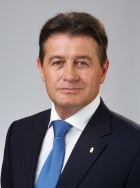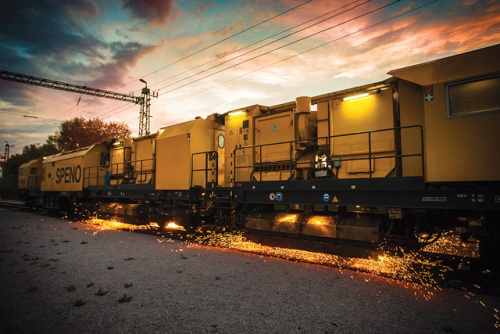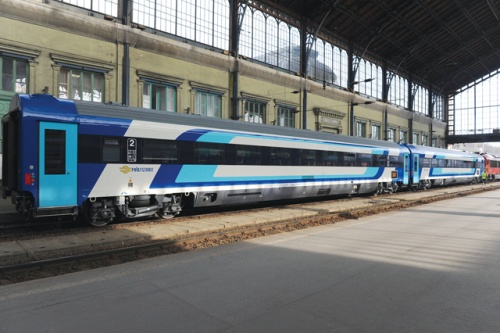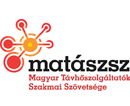‘This is where the future of the railway will be determined’
 László Tasó
László TasóHow big is the EU subsidy which could cover the railway developments in the next seven years?
– In the programming period starting this year, the railway developments can also be financed from the 1,134 billion frame amount of the Integrated Operational Programme for Transport Development (IKOP). Since the submission of the tender in June, the IKOP has been awaiting for Brussels’ approval. Another main fund is also available in the form of a tender, namely the Connecting Europe Facility (CEF), with a total frame of 373 billion forints. In the calls prospectively available from autumn, subsidies can be obtained for the development of the selected European core transport network sections. We actually know about a claim of nearly 3,000 billion worth medium-term railway development, so it is particularly important to come up with wisely ranked and carefully prepared projects. We are absolutely positive that we will spend more than 80 percent of the CEF frame on the railway system.
Can we expect any domestic funds?
– Of course, the biggest item, however, is certainly going to be the 15 percent Hungarian budget contribution to the EU funded development projects.
The development of the Budapest suburban rail transport has been delayed for many years. When can we see progress in this field?
– The progress is already noticeable: The most important transport development of the latest completed EU cycle was the comprehensive reconstruction of the Kelenföld-Tárnok railway line section. The investment established schedule developments between the capital and Székesfehérvár unprecedented for a long time, in the Transdanubian contexts. Passengers travelling to Veszprém, Nagykanizsa and Zalaegerszeg can enjoy the benefits of the biggest offer diversification in years. Budapest suburban traffic provides 55 to 60 percent of the annual passenger traffic of MÁV-START Plc. On an average working day, about 120,000 passengers choose the railway in the agglomeration zones. Therefore it is not an exaggeration to say that this might be decisive for the future of the railway. Being aware of this fact, the Government continues to give priority to the development of suburban transport.
 Rail grinding machinery at work (Photo by Balázs Szecsődi, NIF Plc.)
Rail grinding machinery at work (Photo by Balázs Szecsődi, NIF Plc.)In addition to the ongoing investments in the Budapest agglomeration zones, we are planning railway reconstructions covering more than 200 kilometers. The preparation of complete line reconstructions between Budapest-Veresegyház-Vác, Biatorbágy-Tata-Hatvan and Budapest-Pusztaszabolcs is already in progress. One of our plans is to reconstruct sections connected to the metropolitan area, railway stations and railway bridges so that they can put up with the increased load. We also continue our fleet renewal: due to the ongoing purchase, MÁV-START Plc. will obtain a 102-piece FLIRT motor train fleet by the end of next year. The worldwide unique fleet size can be operated very economically. According to the plans, the passenger rail company is allowed to purchase 70 additional modern motor trains within 5 or 6 years, therefore MÁV-START can accomplish its Budapest suburban traffic vehicle restoration programme in this decade. Large investments are supplemented by the restoration of stations and stops, the establishment of P+R and B+R parking areas, as well as the modernization of the passenger information system. Passengers can experience continuously and rapidly improving service quality in the suburban rail transport.
The Government’s goal in the coming years is further strengthening of an effective and responsible organization, which utilizes the public resources more efficiently, Miklós Seszták outlined, adding that the efforts have already brought about a number of tangible results, since every year more and more people choose the rail transport. The minister added that this trend should be strengthened further, and the other challenge is the modernization of the railway lines and fleet. The head of Ministry also pointed out that he considered giving an impulse to the prestigious national railway vehicle production, which would be based on world-class engineering knowledge to create new jobs, also contributing to the activation of suppliers.
We have severe shortfall in the electrification of railway lines. May this change in the coming years?
– Approximately one third of the total Hungarian railway network is electrified, however, this makes up almost 90 percentage of international main lines determining our domestic traffic to a large extent, which is much more favourable. Within the framework of the IKOP, we are planning to carry out a number of smaller scale developments to implement the electrification of some specific lines and eliminate bottlenecks. Besides the more efficient use of resources, passengers will also experience a dramatical increase in the service level on trains, outside the trans-European network as well.
Compared to the figures in 2002, the number of the railway accident victims has dropped to one-fifth. Can we explain this upward trend?
– MÁV and GYSEV, with their targeted actions seek to improve the safety of road crossings, which are the spots of the vast majority of accidents. On account of this, a variety of instruments have been mobilized: the highest risk intersections have been fitted with boom barriers, manual barriers and signals have been replaced by electronic systems. Furthermore, intensified checks take place several times a year, in cooperation with the police force, while informational films, leaflets are shown to primary and secondary school students to present the risks. Within the New Széchenyi Plan Transport Security Programme, developments for safer crossings and interventions aimed at modernizing security mode are being carried out by the railway companies, for a value of over 18 billion forints. The introduction of more stringent regulations, the installation of power-operated carriage doors which cannot be opened en route, as well as the spread of motor trains all helped a lot.
 Construction of IC+ carriages in the vehicle repair workshop in Szolnok, MÁV-Gépészet Zrt. – MÁV Engineering Ltd. (Photo by Katalin Bőhm, MÁV Plc.)
Construction of IC+ carriages in the vehicle repair workshop in Szolnok, MÁV-Gépészet Zrt. – MÁV Engineering Ltd. (Photo by Katalin Bőhm, MÁV Plc.)When can you start the operation of the Interoperable Railway Communication (GSM-R) signalling and safety systems?
– The development of the ETCS system is already in progress at several places. In accordance with the concluded contract agreements, the installation works can first be completed on the Bajánsenye-Boba, Budapest-Székesfehérvár and Budapest-Lőkösháza railway lines. The first phase of GSM-R development involving 905 kms of railway will be launched this summer. We are planning to apply an interoperable railway communication system on nearly 2,500 kms of railway lines by 2020.
Is there any chance of eliminating the bottlenecks on the core network corridors of the Trans-European Transport Network (TEN-T) in this cycle?
– We would like to achieve much more on the TEN-T core network: we are planning mainly comprehensive reconstruction works where they can be supported by traffic and operating requirements, as well as calculations of return. Along with this, of course, it is possible that in some places the removal of bottlenecks is a reasonable alternative. However, we must not ignore that the improvement results in the TEN-T network should also meet interoperability requirements.
What other large-scale developments, station and railway line reconstruction and modernization projects can be expected in the near future?
– The Government has not approved the IKOP list of improvements yet, so it would be premature to talk about specific projects. Generally speaking, we are interested in using the transport development resources dedicated to the sub-sector development for the eradication of the TEN-T rail speed restrictions, for station modernisation, as well as the purchase of motor trains and track maintenance machinery. We also keep on our priority list suburban railways, suburban rail transport, railway communication, signalling and safety system development and electrification projects.
The debt stock of the MÁV Group, which was 300 billion HUF in 2010, has now been reduced to 220 billion HUF. What steps had to be taken to achieve this goal?
– For many years, the Hungarian State has fully paid the parts of the ordered passenger transport and track operation public services, which are not covered by revenues. Accordingly, the increase of the debt stock of MÁV Group has stopped. We permanently assume the previously taken state-guaranteed loans, within the range of the actual budget deficit limits. For the railway company’s main activities, we have created a stable and predictable funding framework via long-term public service contracts. Consequently, the company can meet its ongoing debt service payment tasks. In the period ahead, we will have to settle the remaining historic debt, and continue the commenced organizational change. One of the most important tasks for the next year is the conclusion of a new operating contract, which permanently ensures delivery of the highest quality public services.
The transport cooperation of the Visegrád Group Countries can help to enhance the region’s competitiveness. What steps has the Government taken with this aim?
– An efficient transport network is an essential prerequisite for a well-functioning economy. The European Union has achieved significant progress in the creation of the East-West rail and road transport links for the past twenty years. As a direct continuation, we must work to develop a similar quality of infrastructure in the Eastern edge of the EU and in the North-South directions as well. Among others, the reasons behind the still existing competitive disadvantage of the Visegrád Countries are uneven economic and logistical conditions. A close cooperation among the countries in the region and joint transport infrastructure development may lead to the elimination of the bottlenecks.
On the initiative of the Hungarian presidency, in March this year, a high level group was set up, dealing with the transport links of the V4 countries. The panel provides permanent consultation forum to coordinate the development of transport links. The participating countries have accepted a precise roadmap for the common measures. The coordinated action may provide a better bargaining position when planning the next EU budget and formulating the utilization regulations for the European transport development financial assets. Hungary has not only managed to launch an initiative for the development of the regional North-South transport links, but also to convey its significance to the partner countries. Slovakia, receiving the presidency may also prioritize deepening cooperation in the programme.
The reconstruction of the Budapest-Belgrade railway line, which can currently compete only with bicycles, is also important for passenger and freight traffic. When will it be worth choosing the railway on this line instead of two-wheeled means of transport?
– During the development of the Hungarian National Transport Strategy (NKS), a preliminary feasibility study has been created for the Hungarian section of the Budapest-Belgrade railway line, including a multi-variant development speed analysis and cost estimation.
The project preparation may begin after the clarification of the funding issues, and it will require continuous and effective cooperation between the two countries. One of the first steps of establishing joint work would be to determine the schedule. Therefore, for the time being, no specific answer can be given to the question concerning the expected realization time of the development project.
In late June, investment negotiations between the China Development Bank (CDB) and the Hungarian Government for the V0 railway line were resumed, after China Development Bank had appointed its new leader responsible for Hungary. What impact may this new line have on Hungarian freight transport?
– The primary purposes of the V0 bypass railway line avoiding Budapest from the South are the diversion of a considerable proportion of the freight traffic currently passing through the capital and the reduction of freight traffic on the suburban lines and at stations.
From the realization of the V0 project we expect significant transit freight transport acceleration, expansion of capacity, and a high degree improvement of traffic predictability. The construction of the new line will allow the full or partial separation of freight and passenger traffic.•



























